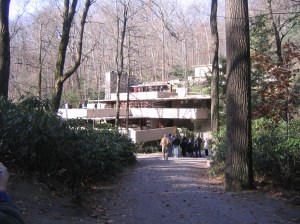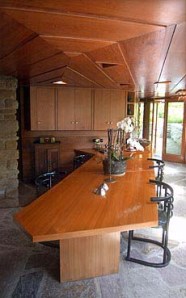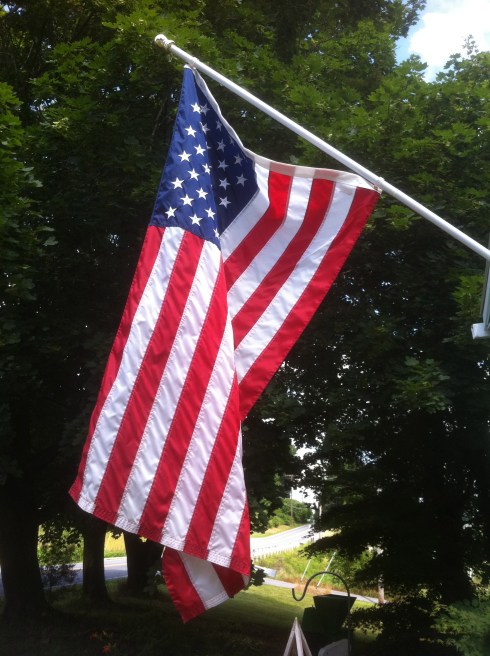—————————————————–
This article originally ran in Mason-Dixon ARRIVE magazine.
Visit https://www.facebook.com/mdarrive to learn more about the magazine and community.
—————————————————-
Discovering America’s Architect
In Our Own Backyard

Nestled among the woods and rocks of Western Pennsylvania’s Laurel Highlands are two amazing Frank Lloyd Wright houses. Fallingwater, with its cantilevered balconies and waterfall, is perhaps Wright’s most famous house. Seven miles away and high above the Youghiogheny River Gorge is Kentuck Knob, one of Wright’s Grand USONIAN designs.
When Anna Lloyd Jones Wright came home from the 1876 Centennial Exhibition she brought her young son, Frank, a box of Froebel blocks. Froebel invented the blocks to teach children how big shapes were made up of smaller parts, and Frank learned that these simple geometric shapes could be used to make any thing. A few years later when Frank was sent to help at the family farm he developed a love of nature, and was often amazed to find the simple shapes of his blocks in the lush green landscape. Wright drew on both of those formative experiences when he designed Fallingwater and Kentuck Knob.
In the midst of the Great Depression Frank Lloyd Wright found it difficult to land interesting commissions. The bureaucrats in Washington were the only ones doing any building, and they preferred a more classical approach over Wright’s “Organic Architecture”. So Wright busied himself with his school, Taliesin. One of his students, Edgar Kaufmann, jr. (Edgar, jr. never capitalized the “j”) invited Wright to his family’s vacation cabin in the Laurel Highlands. As they walked along Bear Run Wright was enchanted by a waterfall crashing over the rocky ledges. It was one of the Kaufmanns’ favorite gathering places, and he decided then and there to locate their new home on the spot.
“Fallingwater was built from 1936 to 1939 so Wright was 67 years old. He was in a fallow period in his career. He’d just written his autobiography and he wanted show that he could design something dynamic.” Says Cara Armstrong, Curator of Education at Fallingwater, “He went on to do some of his biggest projects, including the Guggenheim, in the decades after designing Fallingwater.” Armstrong advises visitors to “Keep your eyes open and you’ll be rewarded by seeing things differently. Wright used the same ideas on multiple levels.” For example, he used the concept of the cantilever on both the bookcases and the floors of the house.
Because the house is cantilevered “the support is only on one side. So one side is mostly stone and one side is mostly glass.” The large banks of window offer an amazing vista of the woods surrounding the house. Originally Wright wanted to cover the concrete with gold leaf to reflect the changing landscape and the natural setting. That was considered too extravagant by the Kaufmanns, so he painted the concrete instead. The color of the concrete is based on the back of a fallen rhododendron leaf.
He used two of his favorite architectural tricks, darkness to light and compression to release, to direct occupants to the more public areas of the house, like the living room and the balconies. He would repeat these techniques to make smaller homes feel much larger.
So what about the waterfall? The Kaufmanns were surprised that Wright planned to locate their house, not facing the fall, but on top the fall. A set of steps lead from the living room down to the natural rock platform at the top of the falls. With the windows open the house is filled with the soothing sound of water rushing over the rocks. Fallingwater, says Armstrong, is a “very spatial experience, you’d never get the same feeling from a book or the web site.”
With an annual operating budget of $4 million Fallingwater is a major tourist attraction in South West Pennsylvania. Albert Einstein was a guest of the Kaufmanns and celebs such as Brad Pitt and Angelina Jolie have toured the building. Reservations are strongly encouraged. The House is open mid-March through Thanksgiving, but is closed on Mondays. Beyond the regular tour you can also take a special Family Tour (perfect for children 5 and up), a two hour in-depth Tour, or a Sunset Tour that ends with light hors d’oeuvres served on the pottery terrace. Call 724-329-8501 for more information or to make a reservation. http://fallingwater.org/

Dining Room at Kentuck Knob
The Kaufmanns were friends with another prominent Western Pennsylvania business family, the Hagans. I. M. Hagan owned Hagan Ice Cream, now a division of Kemps Ice Cream. The Hagans visited Fallingwater several times, and when they purchased an 80 acre parcel of land nearby they hoped that Frank Lloyd Wright would design their home too.
The 86 year old Wright was very busy at the time. He was working on the Guggenheim Museum and the Beth Sholom Synagogue as well as 13 other private residences. The famous architect never stepped foot on Kentuck Knob. He designed the house based on arial photos and detailed land surveys.
What he created was a 2,400 square feet Grand USONIAN. Lee Martin, a Kentuck Knob guide, explained that Wright believed you could have an “ascetically pleasing (house) for a price you could afford.” USONIAN houses were designed to on modest, affordable scale. USONIAN stands for United States of North American Nation (the extra “I” was added to make it easier to say.)
Like the approach to most USONIANs, the “public side” of the house is almost fortress like. The cantilevered roof puts all it’s weight on the stone core. Since Wright didn’t need the walls to bare the roof’s weight, he designed a unique wooden clerestory (a tall wall with a strip of small windows at the top). With the windows open, the wood screen allowed the family ultimate privacy from approaching guests, while still providing a cooling breeze.
The private side of the house is lined with floor to ceiling windows and a cantilevered wrap around terrace. Wright designed hexagonal skylights (the house is built on a hexagonal grid, there are almost no right angles) in the roof overhang to allow light into the sitting and dinning rooms. He carefully considered how the light would hit the top of the mountain during different parts of the year. The skylights let light in all year long, but they also bring a cozy warmth in the winter.
Another Wright innovation is an invisible window in the “corner” of the living room. Wright designed a large window set into the stone surround with out a sill or frame. Matching indoor/outdoor moss gardens create the illusion of a mirror.
“USONIAN houses,” noted Martin, “have a tall central core with a fireplace and kitchen, wings for living areas and sleeping areas go off in different directions.” The bedroom wing’s hip to ceiling windows allow an up close and personal look at the abundant nature outside. Residents of the master bedroom would some times wake to see a deer nestled into the warm niche outside their window.
Using stone from a local quarry and Tidewater Red Cypress Wright created a warm rich interior that embodied his ideal of organic architecture.
The architect, who had seen too many of his houses burn down, opted to use copper for the roofing. It’s soft patina adds to the home’s welcoming feel.
Bernardine Hagan had both a sense of style and nerves of steel. She got her way with the notoriously rigid Wright several times. As a business woman in the food industry, Ms. Hagan wanted stainless steel countertops, as opposed to the traditional Wright Indian Red Clay. Wright allowed the change IF Mrs. Hagan could design it herself and find some one else to install the countertops. She did. Mrs. Hagan also requested and received a basement (something Wright abhorred) and an expanded dining room.
In 1986 Mrs. Hagan sold the house to Lord Peter Palumbo, an avid art collector and member of the British House of Lords. He opened the house to the public a decade later. The Palumbos have added an extensive Sculpture Garden that houses 35 major works of art. The house is decorated with a mix of original Wright designed furniture, including some pieces rescued from the Imperial Hotel in Japan, and Palumbo’s more modern art.
Kentuck Knob is open daily from March 31st to December 31st. Regular tours run Tuesday through Sunday from 10 to 4 and on Mondays at 12, 2 and 3. Other tours include an In-depth Tour and a special Sunset Tour on selected dates. Call (724) 329-1901 to make a tour reservation. http://www.kentuckknob.com/
Several nearby hotels offer Wright Packages. “The Wright Experience” at Day’s Inn covers admission to both houses, overnight accommodations and a continental breakfast. Mountain View Inn offers the “Classic American Getaway” with stops at the Westmoreland Museum of American Art, Fallingwater, Kentuck Knob and the Christian W. Klay Winery, Dinner, Breakfast and deluxe accommodations. If you are looking for the ultimate Wright weekend consider spending the night IN a Wright house at Polymath Park Resort, 30 miles away. The Resort features Wright’s relocated Duncan House and two houses designed by Wright apprentice, Peter Berndtson.
A weekend discovering America’s Architect will change the way you look at architecture and the world around you.








